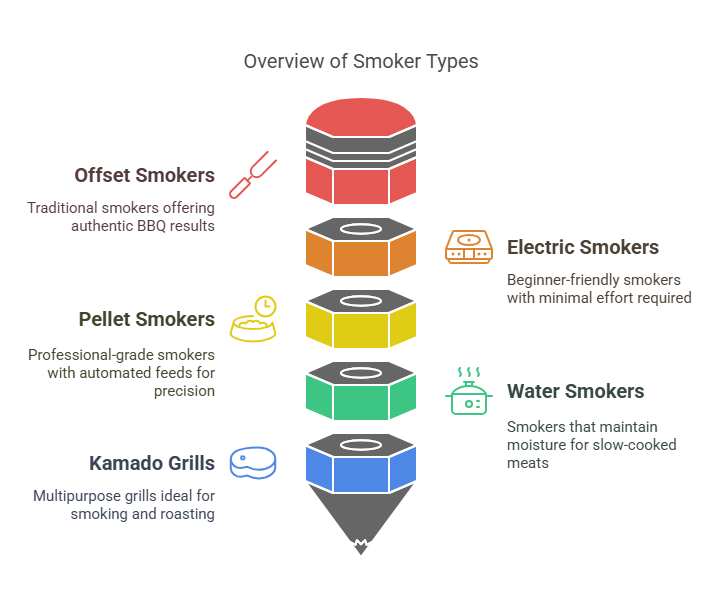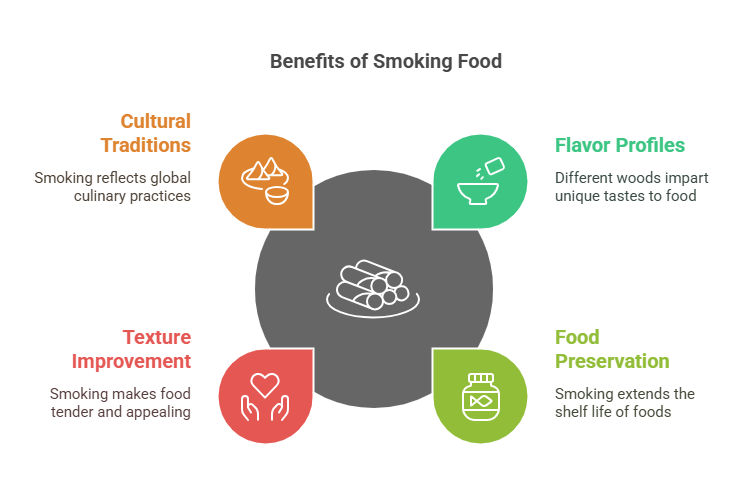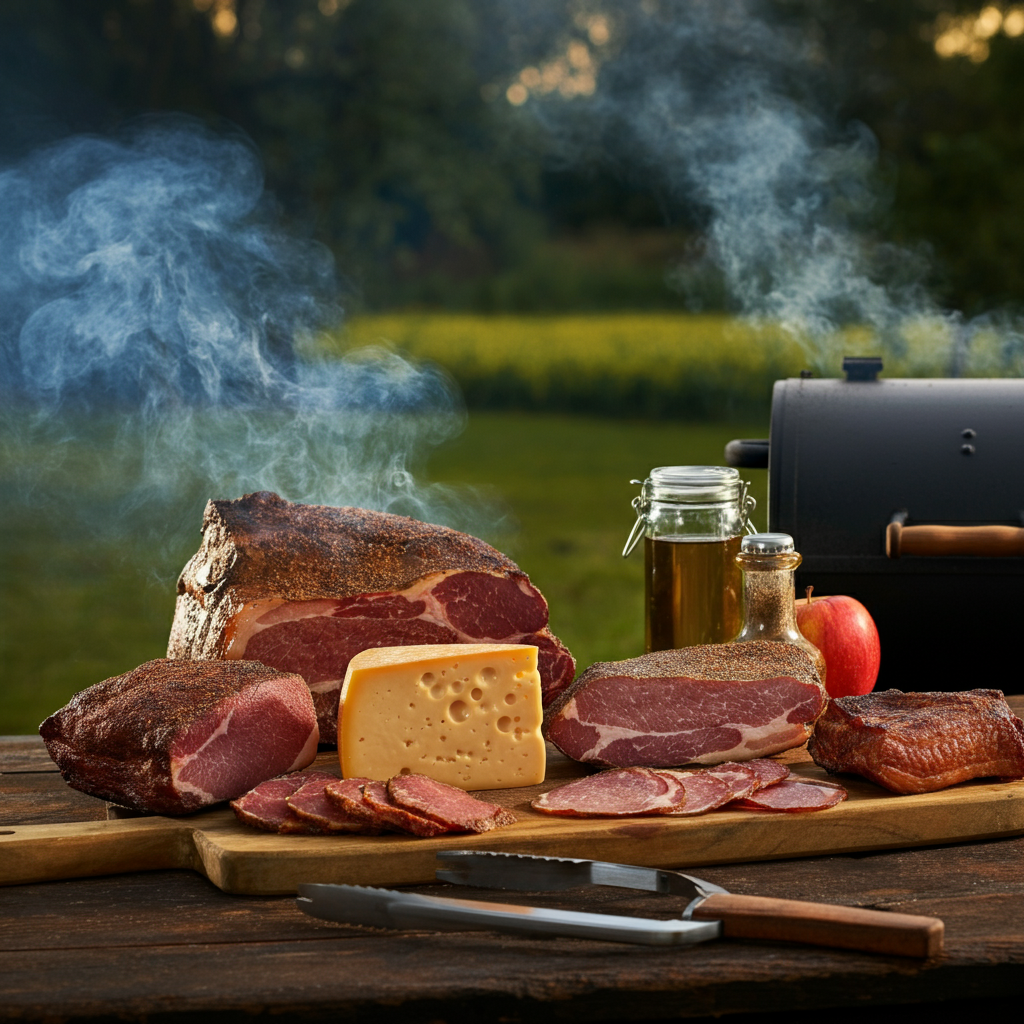Imagine sinking your teeth into a perfectly smoked brisket — tender, juicy, and bursting with a smoky depth of flavor that you can’t achieve with any other cooking method. That’s the magic of smoking method. A practice born from ancient preservation needs, smoking food has transformed into a celebrated culinary art embraced by pitmasters, chefs, and home cooks.
Whether you’ve daydreamed about smoked ribs at your next barbecue or wondered how smoked salmon gets its rich texture, this guide has it all. We’ll explore the history, types of smoking method, equipment, benefits, and expert tips to help you master this revered cooking method.
Let’s light the fire and get smoking!
What is Smoking Method, and Why is it Special?
Smoking method is a cooking method where food is exposed to smoke from burning wood, often at a low temperature for an extended period. The result? Unique flavors, stunning textures, and, in some cases, preserved longevity.
Its roots can be traced back to ancient cultures that smoked food to preserve it before refrigeration existed—a brilliant blend of necessity and innovation! Over time, these techniques evolved, giving us culinary staples such as American BBQ, Nordic smoked fish, and even smoked cheeses.
Unlike grilling or roasting, smoking method operates at lower temperatures (usually 200-275°F for hot smoking), which allows flavors to infuse deeply while maintaining the food’s juiciness. Slow and low is the mantra—think of it as the food equivalent of jazz music.
Today, smoking method isn’t just for the pros. Home enthusiasts armed with electric smokers or even makeshift equipment can achieve restaurant-quality results.
Smoked Foods Are Having a Moment
Smoked brisket platters, smoked tofu, smoked cocktails—check any trending food blog, and you’ll see how popular smoking has become. A growing appreciation for bold, complex flavors is fueling interest, making smoking method a must-try technique for food lovers everywhere.
Types of Smoking Methods
Smoking method isn’t a one-size-fits-all technique. There’s a method for every type of cook, from beginners seeking simplicity to experts chasing precision.
1. Cold Smoking Method
Cold smoking method involves curing food with smoke at low temperatures (less than 90°F). Instead of cooking, it’s used to flavor and preserve foods like cured meats, cheeses, and fish. Think smoked salmon or Gouda!
Best For: Preserving, subtle flavor infusion
Equipment & Example: A cold smoker or box smoker; smoked salmon
2. Hot Smoking Method
Hot smoking method cooks and flavors food simultaneously, with temperatures ranging from 200 to 275°F. This is the technique responsible for BBQ classics like brisket, ribs, and smoked chicken.
Best For: Meat cuts, poultry, hearty vegetables
Equipment & Example: Electric or wood pellet smoker; smoked brisket
3. Smoke Roasting (Hybrid)
A hybrid of roasting and smoking, this technique uses higher temperatures (up to 350°F). Smoke-roasted foods have both char and rich flavor.
Best For: Thick meats, whole poultry
Equipment & Example: Kamado grills like the Big Green Egg
4. Liquid Smoke (Urban Alternative)
Don’t have a smoker? Liquid smoke offers a practical alternative to infuse flavorful hints in urban kitchens. Many use it for marinades and sauces.

Smoking Equipment Essentials
No, you don’t need a backyard pit, but good equipment makes a difference. Here’s a breakdown of what works best.
Types of Smokers
- Offset Smokers: Traditional charcoal/wood smokers offering control and authentic BBQ results.
- Electric Smokers: Great for beginners, providing steady heat with minimal work.
- Pellet Smokers: Automated feeds for precision smoking, loved by pros.
- Water Smokers: Maintain moisture for slow-cooked meats (e.g. Weber Smokey Mountain).
- Kamado Grills: Multipurpose grills perfect for both smoking and roasting.
Accessories You Need
- Wood Chips & Chunks: Hickory for bold flavors, fruitwoods like apple for a sweet edge.
- Thermometers: Essential for monitoring food temps and ensuring safe cooking.
- DIY Hacks: No smoker? Create one using a wok or your grill paired with soaked wood chips.

Why Smoke Your Food? The Benefits
1. Flavor Explosion
Smoking method creates one-of-a-kind taste profiles determined by the wood you use.
- Hickory: Bold, slightly sweet
- Applewood: Light, fruity
- Mesquite: Strong, earthy
Choose your pairing wisely—applewood chicken offers a milder experience, while mesquite beef delivers an intense punch.
2. Food Preservation
Beyond flavor, smoking method was historically used to extend meat and seafood shelf life. While we no longer depend on it for preservation, smoky foods retain that nostalgic feel.
3. Unmatched Texture
The low-and-slow process breaks down connective tissues in meat, creating tender, fall-off-the-bone results. Smoked cheeses gain depth too, with melt-in-your-mouth appeal.
4. Cultural Storytelling
From classic Texas BBQ briskets to Nordic smoked salmon, smoking connects us globally through cherished traditions.

Beginner Tips for Smoking Success
Starting out? Here are practical tips to ensure your first time smoking is foolproof.
Pick Your Proteins and Pairing
Smoked chicken and ribs are beginner-friendly choices. Pair with mild woods like alder or applewood.
Control the Temperature
Invest in a thermometer and aim for consistent lows (225°F for meats). Uneven heat ruins flavor!
Use Brines and Rubs
Marinate meats or use spice rubs to lock in moisture and intensify flavor during the smoking process.
Safety First with Cold Smoking
If attempting cold smoking, ensure food stays out of the “danger zone” (40-140°F) to avoid bacterial growth.
Start Small
Try simpler recipes like smoked vegetables or chicken thighs before tackling a 12-hour brisket cook.

Common Mistakes to Avoid
- Over-smoking: Too much smoke can leave food bitter. Start subtle—less is more!
- Wrong Wood Use: Avoid pine or softwoods—they release resin and unpleasant flavors.
- Skipping Cleanup: A clean smoker ensures consistent flavors and functionality.
Level-Up with Advanced Techniques
Reverse Searing
Smoke your steak first, then sear for a beautiful crust and smoky depth.
Multi-level Smoking
Use smoker racks to simultaneously infuse meat, veggies, and even desserts (smoked cheesecake is a trend!).
Infusing Smoky Flavors Without a Smoker
Experiment with smoke guns or add smoked paprika to recipes for bursts of flavor.
Frequently Asked Questions (FAQ)
1. How Long Does Smoking Take?
Timings vary. Brisket may take 12 hours, but chicken cooks in as little as 2-4 hours.
2. Which Smoker Should Beginners Buy?
Electric or pellet smokers—they offer easy temp control for learning the ropes.
3. Can I Smoke Indoors?
Use liquid smoke or stovetop smokers, but ensure good ventilation to avoid fire hazards.

Get Smoking Today!
From fragrant applewood chicken to robust mesquite brisket, smoking elevates food to memorable heights. Think of it as flavoring your meals with time and craft.
Whether you’re a beginner or seasoned cook, smoking invites experimentation and bold creativity into your kitchen. If you’re ready to fire up your smoker—or try adding smoky flavors to your favorite foods—this guide has you covered.
What’s your next move? Perhaps it’s trying smoked salmon, or maybe ribs? Drop your favorite smoking recipes—or share tips—in the comments below!
And don’t forget to check out our Cooking Methods Blog Post to deepen your culinary game. Happy smoking!
📌 Stay connected with us!
- Follow us on Instagram: @RoastedKitchen25 for daily cooking inspiration.
- Tag us in your creations using #RoastedKitchensmoked—we’d love to see what you make!
- Subscribe to our newsletter for exclusive recipes, expert tips, and kitchen hacks straight to your inbox!
Frequently Asked Questions (FAQ)
1. How long does smoking different foods take?
The smoking duration depends on the food type and the method used. For instance:
- Brisket can take 10-14 hours at 225°F for tender, juicy results.
- Ribs typically take 4-6 hours in a smoker.
- Chicken cooks in around 2-4 hours, depending on size.
Always monitor the internal temperature of the food for doneness.
2. Which smoker is best for beginners?
For beginners, electric or pellet smokers are the easiest to use. They provide steady heat and require minimal adjustments:
- Electric Smokers are straightforward and reliable for set-it-and-forget-it smoking.
- Pellet Smokers add versatility and consistent temperature control, making them great for learning.
3. Can I smoke food indoors?
Smoking indoors requires specialized tools to ensure safety and avoid excess smoke buildup:
- Use a stovetop smoker or small indoor smokers designed for kitchen use.
- Incorporate liquid smoke into marinades and sauces if you don’t have an indoor smoker.
Safety Tip: Ensure proper ventilation and avoid open flames in enclosed spaces.
4. What’s the difference between cold smoking and hot smoking?
- Cold Smoking cures food and imparts flavor at temperatures below 90°F. It’s often used for items like smoked salmon, cheeses, and cured meats. Cold smoking doesn’t cook the food, so additional preparation or preservation is often required.
- Hot Smoking cooks and flavors food simultaneously at temperatures of 200-275°F, making it ideal for brisket, ribs, and chicken.
5. What types of wood should I use for smoking?
Wood type affects flavor significantly:
- Hickory: Bold and smoky, ideal for ribs and brisket.
- Applewood: Light and fruity, perfect for chicken or fish.
- Mesquite: Strong and earthy, great for beef.
Experiment with blends (e.g., mixing applewood and hickory) to balance flavors.
6. Is smoking food safe?
Yes, if done correctly. Follow these safety tips:
- For cold smoking, ensure food stays out of the bacterial “danger zone” (40-140°F).
- Always use a food thermometer to verify internal temperatures—165°F for poultry, 145°F for fish, and 190-205°F for brisket.
- Use hardwoods instead of softwoods like pine, which release resin and toxic smoke.
7. Can I use my regular grill to smoke food?
Yes! You can turn a regular grill into a smoker:
- For gas grills, use a smoke box filled with soaked wood chips and set on indirect heat.
- For charcoal grills, arrange coals to one side and place wood chunks on top, creating a two-zone setup for indirect smoking.
8. What are some beginner-friendly smoked foods to try?
Start with easy options:
- Smoked chicken thighs or wings (quick and forgiving in the smoker).
- Smoked salmon, which requires less time and pairs well with mild wood flavors like alder.
- Simple ribs with a dry rub to build confidence.
9. What are common mistakes to avoid when smoking?
- Over-smoking: Too much smoke can make food bitter. Use only moderate amounts of wood.
- Neglecting temperature control: Keep a steady heat; fluctuating temperatures can ruin food texture or flavor.
- Skipping Food Prep: Don’t skip brining, marinating, or seasoning, as they enhance flavor and moisture retention.
- Using the wrong wood: Avoid softwoods like pine that release unwanted flavors.
10. What are the benefits of smoking food?
- Flavor: Smoking infuses food with unique, smoky depths.
- Texture: Tough cuts like brisket become tender through the low-and-slow process.
- Preservation: Smoking historically extended food shelf life. While not necessary today, it remains a tribute to culinary tradition.
- Versatility: Smoking suits proteins, vegetables, and even cheese or desserts like smoked cheesecake.
11. Are there alternatives to a smoker for urban kitchens?
Yes! Urban kitchens can still enjoy smoky flavors:
- Use liquid smoke as a quick flavor enhancer in recipes.
- Invest in a smoke gun or cloche for cold-smoke effects on smaller items like cocktails or cheese.
- Try stovetop smoking pans or DIY smoker setups using a wok and foil-covered wood chips.
12. Is smoking method an environmentally friendly cooking method?
Smoking method, particularly using natural wood or sustainable pellets, can be an energy-efficient way to cook. Opt for fuel-efficient smokers like pellet grills, and consider using reusable accessories to reduce waste.
These FAQs tackle the key considerations for aspiring smoking enthusiasts and address common concerns to streamline the learning process. Happy smoking!

Hi, I’m Mayaz Ahsan!
As a passionate cook, storyteller, and food enthusiast, I combine my love for travel, farming, reading, and teaching to bring you insightful culinary tips and stories. Welcome to Roasted Kitchen – I’m thrilled to share this journey with you!










 Subscribe to our free newsletter for tips, tutorials, and insights!
Subscribe to our free newsletter for tips, tutorials, and insights!